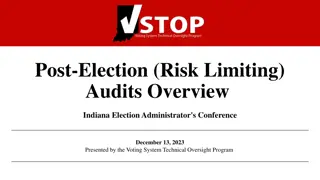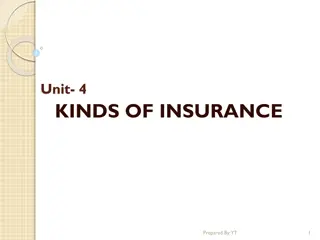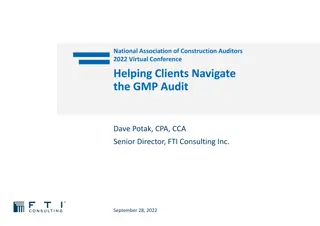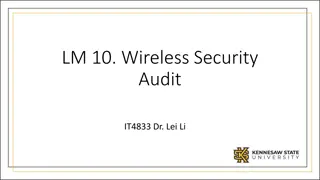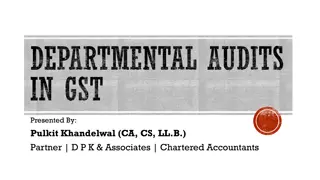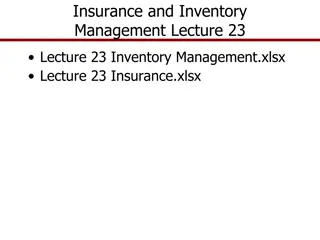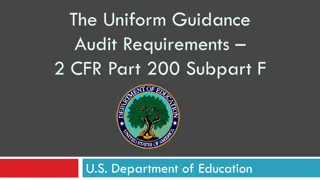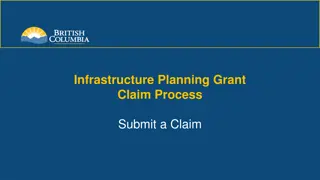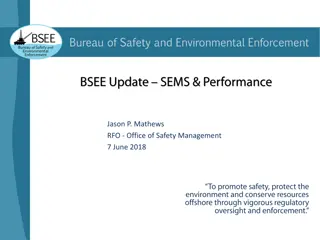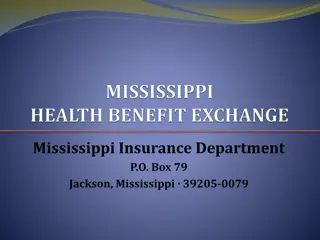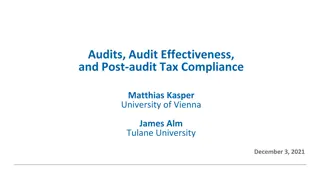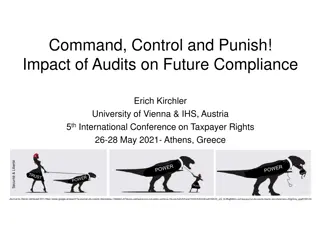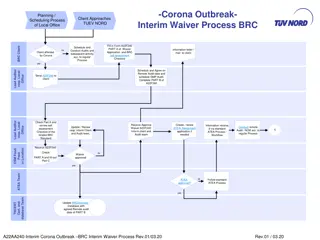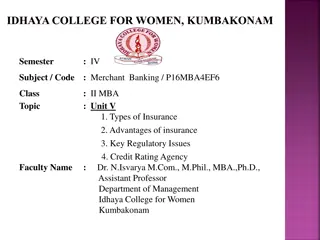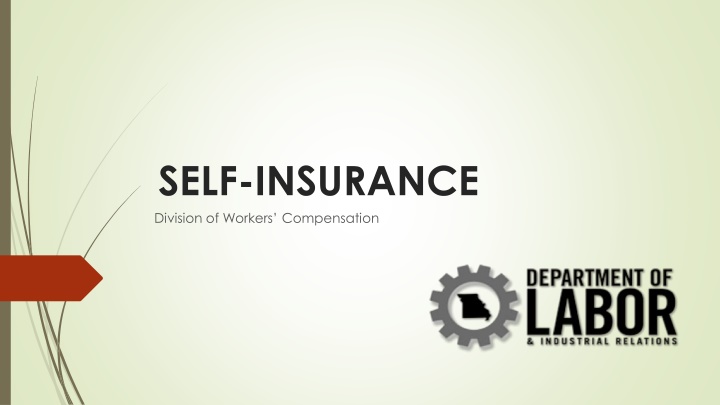
Division of Self-Insurance Claim Audits and Procedures
The Division of Workers Compensation conducts claim audits to ensure self-insurers and trusts are financially sound to support workers' compensation obligations. Types of audits include complaint, reserve, and compliance audits, following specific regulatory procedures.
Download Presentation

Please find below an Image/Link to download the presentation.
The content on the website is provided AS IS for your information and personal use only. It may not be sold, licensed, or shared on other websites without obtaining consent from the author. If you encounter any issues during the download, it is possible that the publisher has removed the file from their server.
You are allowed to download the files provided on this website for personal or commercial use, subject to the condition that they are used lawfully. All files are the property of their respective owners.
The content on the website is provided AS IS for your information and personal use only. It may not be sold, licensed, or shared on other websites without obtaining consent from the author.
E N D
Presentation Transcript
SELF-INSURANCE Division of Workers Compensation
Division of Self-Insurance Claim Audits 8 CSR 50-3.010 Rules Governing Self-Insurance: The Division shall have the authority to conduct audits relating to safety, claims and any other audits deemed necessary and appropriate as determined by the Division.
Why does the Division do claim audits? The Division is the regulator of self-insurers and trusts We ensure the claimants receive all of the benefits they are entitled to under the workers compensation act Self-Insurers, Individuals and Trusts have to be financially sound to support their workers compensation obligations They have to support their losses with security posted to the state
More Reasons for Claim Audits To ensure an Insurer has enough security to cover their losses with the state The Self-Insurance unit s goal is to make the insurers as healthy as possible. A shortfall in the security of a bankrupt self-insurer would result in the Missouri Private Sector Individual Self-Insurers Guaranty Corporation filling the obligations. The Guaranty Corporation processes claims for insolvent companies, thereby protecting the injured workers from losing their ability to collect workers compensation benefits for a work-related injury. If the Insurer is a Municipality, those financial obligations would go back to the taxpayers to pay those Workers Compensation obligations.
Types of Audits Complaint Audits are conducted in response to a complaint received by the Division and are targeted to resolve the immediate complaint. Reserve Audits are typically conducted in connection with the bankruptcy or insolvency of a self-insured employer to determine the adequacy of the security held by the Division based on the case reserves. Compliance Audits are random or specific audits conducted to measure a self-insured employers or group trusts compliance with Missouri Workers Compensation Statute and Regulations.
Audit Procedures Regulatory Review of the: First Report of Injury Form 2 Notice of Commencement/Termin ation of Compensation Answer to Claim for Compensation Stipulation of Compromised Settlement/Award Case File Review for: Case file management File notes documentation Reserving Payment of medical and lost time benefits Direction of medical treatment
FIRST REPORTS OF INJURY (FROI) Injuries are to be reported to the Division when the accident or occupational disease required medical treatment beyond first aid. FIRST AID VS. MEDICAL TREATMENT First Aid is the immediate, temporary one-time treatment for minor scratches, cuts, burns, splinters, or other minor industrial injuries which do not require further medical care. Plain & Simple If an injury incurs a cost, IT IS TO BE REPORTED!!!!
FORM 2 NOTICE OF COMMENCEMENT/ TERMINATION OF COMPENSATION Form 2 Notice of Commencement/Termination of Compensation form is available on the Division s website. This form contains automatic calculations of dates and amounts paid for compensation. The auditors look at the timeliness of reporting from the DATEof the 1st payment and the DATE of the last payment.
MEDICAL REPORT The Medical Treatment Form (WC-9) should be filed with the First Medical Treatment and the Last Medical Treatment
CLAIM FOR COMPENSATION/ANSWER TO CLAIM FOR COMPENSATION Employers/Insurers must file the Answer to the Claim for Compensation within thirty (30) days from the date the Division acknowledges receipt of the Claim for Compensation otherwise the statement of facts in the Claim for Compensation shall be deemed admitted for further proceedings. 8 CSR 50-2.010 (8) (B)
STIPULATION OF COMPROMISED SETTLEMENT/AWARDS All Stipulations and Awards must be approved by an Administrative Law Judge or the Commission. Stipulations and Awards must be paid within 30 days of the date of approval.
CASE MANAGEMENT
FILE MANAGEMENT File Management includes the files, notes, claims systems, and financials of a file. Separate files must be maintained for each individual injury that occurs. The following should be included in a claims file: Case Notes Payment Histories Reserve Worksheets & Histories Wage Statements Medical Reports, Documents & Bills Rating Reports Witness Statements All Medical, State & Legal Correspondence All applicable information/documentation that is pertinent to the injury
FILE MANAGEMENT All files must: Reflect on the current status of each case Be well organized Be updated on a regular basis Have regular reviews to ensure they are being properly maintained
RESERVE MANAGEMENT The Division uses the FASB Rule 5 as a guide for Reserve Management Reserves must be Set for Medical, Indemnity, and Expenses Updated on a regular basis Reviewed and if needed updated as the case progresses and new information is developed Set when the exposure is known Set for the maximum potential exposure based on the most probable outcome of file Specified intervals need to be set for reserve reviews Reserve histories and worksheets must be included in the case files
INVESTIGATION MANAGEMENT All files need to have a thorough investigation completed within a specified time frame and documented in the case notes. The initial investigation should collect all essential items necessary for claim evaluation. Compensability decisions should be made quickly. Employees, supervisors, and any witnesses should complete applicable statements. Continuing investigation throughout the life of the file. Medical releases should be signed by all employees in order to collect medical documentation from outside providers. Based on the investigation, adjusters should develop a plan of action to follow throughout the life of the file.
COMPENSATION MANAGEMENT Wage statements must be received in a timely manner in order to correctly determine the TTD/PPD rates. The TTD calculations must be included in all injury files with lost time and litigated case files. The 3 day waiting period should be recognized on all lost time injuries After the employee has missed 14 days of work, the waiting period is paid retroactively
BENEFIT MANAGEMENT Benefit Management includes the payment of medical and lost time benefits Medical bills should be paid within 30 days of receipt of the bill from the providers Indemnity benefits should be paid as the employee was paid prior to the injury but at no less than 2-week intervals
MEDICAL MANAGEMENT Under Missouri Workers Compensation statute, the employer has the right to direct the Medical Treatment of the injured employee(s). All medical documentation should include: Diagnosis Treatment plan Restricted duty or no work Release dates Disability ratings
CASE CLOSURE Files must contain all documentation to support case closure Final medical reports & bills Released from care Notice of maximum medical improvement (MMI) Disability Ratings All medical bills need to be paid Files need to be closed in a reasonable amount of time after all activity on the file has been completed Files need to be reviewed by both the adjuster and supervisor prior to closure to ensure that the file is ready for closure
CHANGES IN THE AUDIT PROCESS Claim Audits will be every 3-4 years The insurer will receive a list of the open claims with the Division with the audit notice. They will need to confirm what is open according to their loss runs The Division will then audit 20-30% of the open, death, perm totals and medical on an Insurer s loss runs. 15% on larger audits No less than 30 files to review Auditors will begin scheduling a pre-interview with the self insurers prior to the audit. This interview will touch on the upcoming changes to our system as well as discuss safety. Our safety department will also have a larger role in the audit process
THE DIVISION IS MODERNIZING We are not the experts on claims reporting; however, rumor has it there will be changes in submitting your information to the Division. We are moving from EDI Claims Release 1.0 to 3.1 standards to increase the ability to exchange information with data partners. First Reports of Injury will be submitted EDI (Electronic Data Interchange and the Subsequent Report of Injury (SROI)). This will eliminate the need for the Notice of Commencement/Termination of Compensation. All information submitted on the claims will be on FROI-SROI. What does that mean for the Insurers? Most of you must have your system reprogrammed to handle the change. You might want to talk to your vendor if you use a vendor, and they charge per submission. There could be up to five submissions per claim, which may be more costly to file a Claim with the Division
LATE REPORTING OF FIRST REPORTS OF INJURY Under Chapter 287.380.1 RSMo, every employer or their insurer shall file with the Division a complete report of injury or death to any employee within thirty (30) days after knowledge of the injury. Each late report is a violation punishable by up to $500.00. Effective January 1, 2024 IF YOU FILE YOUR FIRST REPORT OF INJURY AFTER THE 30 DAY REQUIREMENT, YOU WILL BE IN VIOLATION OF 287.380.1 RSMo A $500.00 FINE WILL BE IMPOSED ON EACH LATE FIRST REPORT OF INJURY FILED WITH THE DIVISION

